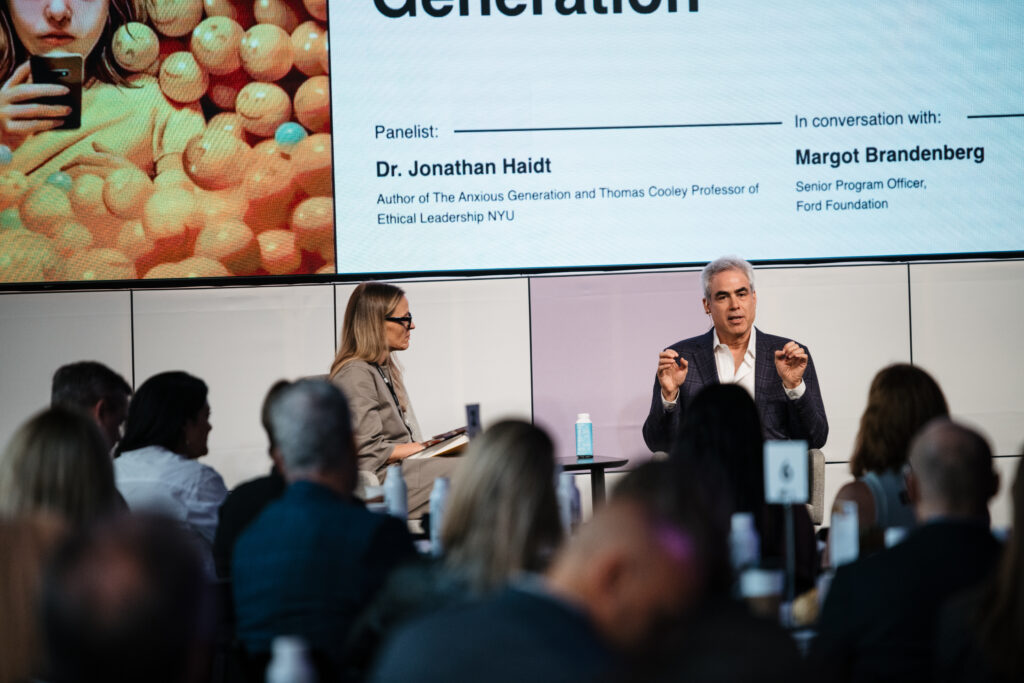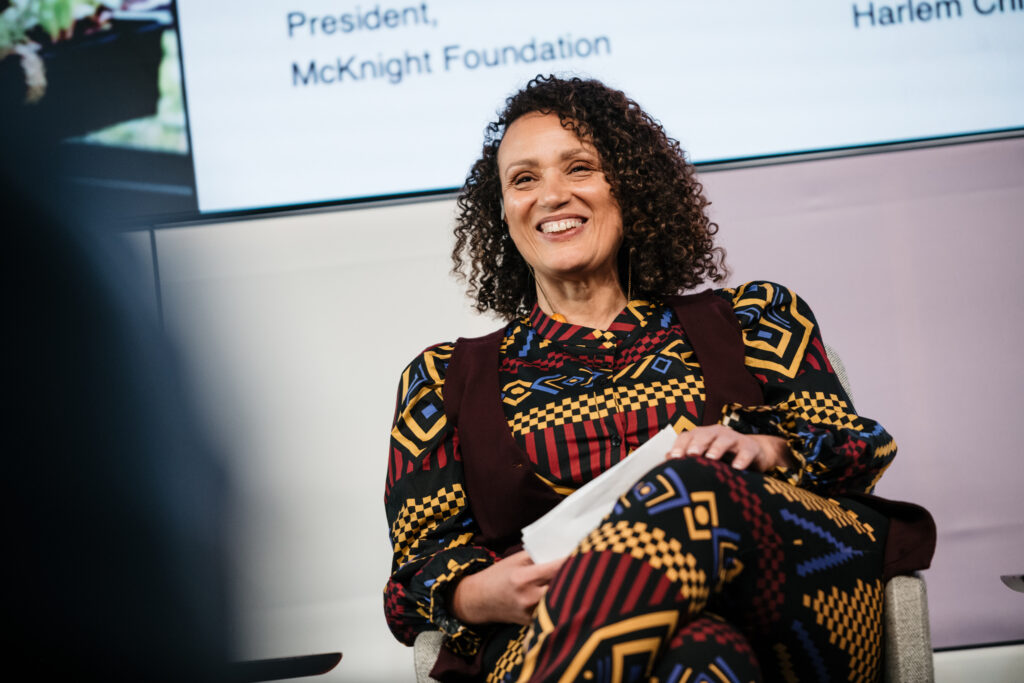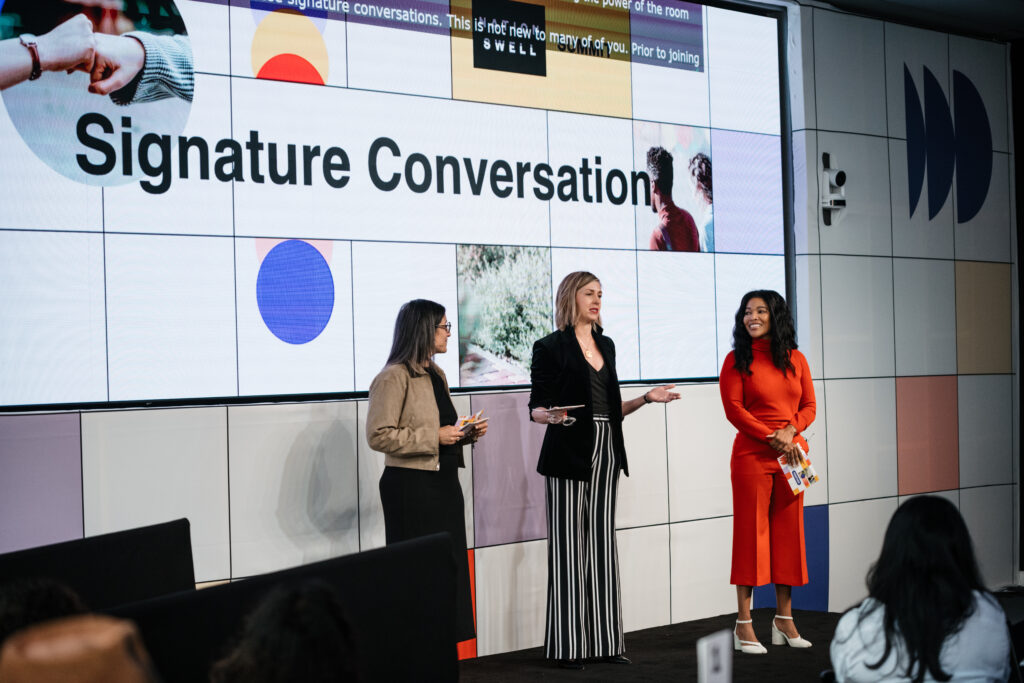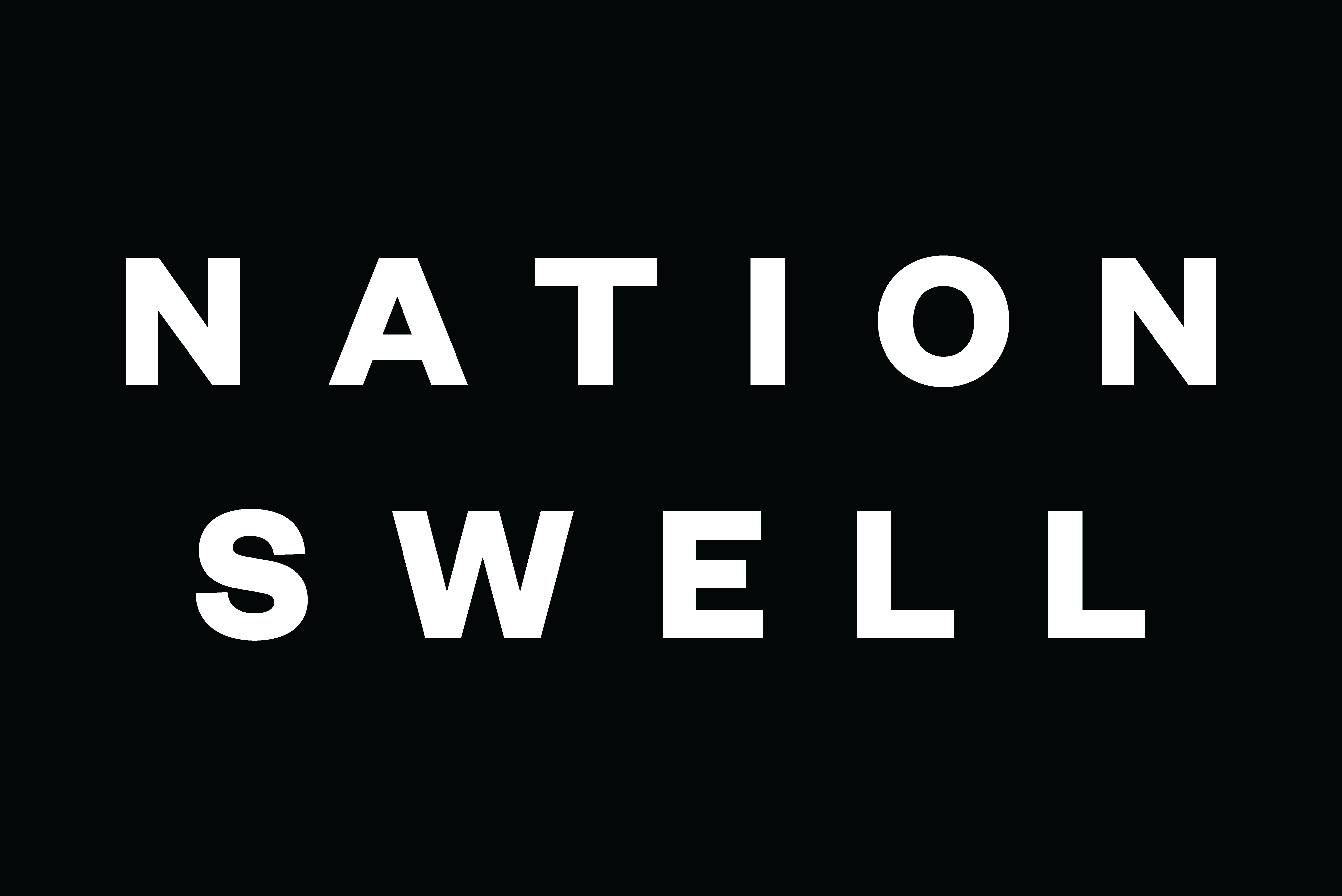On a crisp October morning in New York, more than 250 leaders came together for NationSwell Summit 2025, united by this year’s theme: Together — a call to move beyond silos and into shared purpose. Across the day’s sessions — which spanned across the challenges of childhood in the age of social media and community transformation to healing through sport, collective action, and the future of work — speakers returned to a single truth: our shared progress depends on partnership.
The day’s conversations invited participants to reimagine how we govern technology, build workplaces that nurture every kind of talent, and invest in the local trust and shared purpose that make lasting change possible. Our Impact Spotlights served as powerful and emotional reminders of the good work happening in this community, and included: It’s Time to Make Connection a Cause, featuring Aaron Hurst, U.S. Chamber of Connection; What Teachers Are Telling Us, featuring Alix Guerrier, DonorsChoose; In This Lifetime — Structural Change, Strategy, and Belief, featuring DeRay Mckesson, Campaign Zero; Collaborative Action: Strengthening Public Health by Integrating CHWs featuring Barb Short, Sanofi and Denise Octavia Smith, MBA, CHW, PN, National Association of CHWS; Neurodiversity & The Future of Business, featuring Nathan Friedman, Understood.org; Opening Doors to the AI Economy, featuring Nicole Johnson, Cadence Design Systems and Cadence Giving Foundation; and Together in Action: Unlocking the Power of Corporate Philanthropy, featuring Dale Strange, Blackbaud.
In case you were not able to be with us in the room — or if you’d simply like to revisit the day’s events — we’ve recapped several Summit sessions below:

1. NationSwell’s Book of the Year: The Anxious Generation by Dr. Jonathan Haidt
Featuring: Dr. Jonathan Haidt, The Anxious Generation
Moderated by: Margot Brandenberg, Ford Foundation
“If aliens landed here and we didn’t understand them, would we send our kids off to play with them? Hell no. But that’s what we’re doing with artificial intelligence, and at warp speed.”
— Dr. Jonathan Haidt, author of The Anxious Generation
- Technology has accelerated beyond our social evolution, eroding the very institutions that once bound us together. Humans are deeply social creatures who developed systems like democracy, education, and the rule of law in order to cooperate with each other at scale. But the rapid pace of technological change, especially through social media and AI, is destabilizing those social bonds faster than society can adapt.
- The greatest threat posed by modern technology is that it makes us less reliant on each other. Where we once depended on relationships for knowledge, connection, and decision-making, we now turn to machines and algorithms. This erosion of interdependence undermines empathy, belonging, and the shared fabric of human life, especially among younger generations.
- The smartphone marks a generational rupture unlike any before. The sharp divide between those who went through adolescence before versus after 1995, when smartphones became ubiquitous, has created the first truly distinct digital generation. Rates of anxiety, depression, and dysfunction rise steeply beginning with this cohort, particularly among girls.
- Girls are being crushed under the social and emotional weight of social media, while boys are disappearing into digital addiction. Girls’ mental health suffers from social comparison, online bullying, and exposure to predatory or appearance-based content. Boys, meanwhile, retreat into gaming, pornography, and sports betting — activities that hijack dopamine systems and stunt social and emotional development.
- Parents are caught in a collective-action trap, each feeling powerless to resist norms everyone privately disapproves of. Most children admit they dislike social media but feel compelled to use it to avoid being left out. Families acting alone feel “cruel” denying their kids phones; only collective, community-level norms can reset expectations and make restraint the default.
- Four collective-action norms can restore real childhood and social connection:
- No smartphones before high school.
- No social media before 16.
- Phone-free schools.
- More independence, free play, and responsibility in the real world.
According to Haidt, these shifts would re-anchor children in lived experience rather than addictive digital feedback loops.
- Passive screen time isn’t inherently harmful — but solitary, interactive screen time is. Shared story-based experiences, like movie nights, nurture imagination and moral reasoning. The danger lies in touchscreens that deliver rapid, isolated, reward-based stimuli — training children’s brains for distraction and consumption rather than focus and empathy.
- Mothers have emerged as the unexpected vanguard of reform. Across political lines, grassroots groups of mothers have organized text threads, reading groups, and policy campaigns pushing for phone-free schools and age restrictions. This movement’s bipartisan momentum signals widespread cultural readiness for change.
- AI poses the same relational threats as social media, but on a far greater scale and at warp speed. AI companions already draw teens away from human relationships. Unlike past technologies, AI evolves autonomously and exponentially, with little oversight or liability, amplifying the risks to truth, empathy, and social cohesion.
- Children are not small adults, and AI should not be tested on them. While AI can be a powerful tool for adults, it risks replacing essential developmental struggle with servitude and dependency in children. Until its effects are understood, the safest role for AI in childhood is none.
- Hope lies in collective resistance and community-based action. The success of parent-led campaigns to limit smartphone and social-media use proves society can move quickly when unified. If we can win this fight for childhood, it will build the civic muscle needed to confront even larger challenges — like AI — together.

2. The Power of Place: Community-Driven Impact in Action
Featuring: Tonya Allen, McKnight Foundation; Kwame Owusu-Kesse, Harlem Children’s Zone
Moderated by: Amy Lee, NationSwell
“Together is actually more than a theme. Given the times that we are in, it’s basically a survival tactic. The idea of togetherness is a prerequisite of the work; it’s where transformation endures — understanding that we are our brothers’ and sisters’ keepers. If we want to move the country forward toward pathways of excellence, it is a requirement that we are in lockstep with one another.”
— Kwame Owusu-Kesse, CEO of Harlem Children’s Zone
- Trust and proximity are the foundation of lasting impact. Place-based work succeeds when leaders get close enough to hear the truth from those affected by their efforts. Community proximity creates accountability and keeps change grounded in lived experience rather than abstract theory.
- Place is the true unit of change. Where a child grows up determines much of their economic mobility. By tightly weaving education, health, and economic programs within a defined geography, organizations like Harlem Children’s Zone prove that thriving neighborhoods drive generational progress.
- Build from community assets, don’t fix perceived deficits. Effective place-based work begins with local strengths — aspirations, talents, and collective wisdom — rather than focusing on what’s broken. This approach unleashes creativity and ownership within communities themselves.
“Transformation happens in real places with real people. I think a lot of the time we think of transformation as abstract, and I think that is actually why we struggle with creating real change. We are so far away from the people and the places we want to help.”
— Tonya Allen, President of the McKnight Foundation
- Transformative change requires matching the scale of the solution to the scale of the problem. Incremental fixes cannot close the wealth gap. Initiatives like the GroundBreak Coalition call on institutions holding capital — banks, governments, philanthropies — to redesign systems so wealth flows with “speed and justice” to those long excluded.
- Power in place-based work means organizing people and organizing money. Communities can’t achieve lasting change through engagement alone; financial systems and resources must also be organized intentionally. Those in power have a responsibility to “rewrite the rules” so access to capital and opportunity is fair and attainable.
- Collective accountability is the test of true partnership. When outcomes falter, real collaborators resist finger-pointing and instead share responsibility for results. Joint ownership of successes and failures keeps efforts aligned across the full cradle-to-career continuum.
- Excellence is not negotiable in service of equity. Mission-driven work must meet the same standards of rigor and quality as any enterprise. Communities deserve world-class execution, not “good hearts” without capacity or skill — nonprofit should mean tax status, not lowered expectations.
- Strong relationships and courage sustain collective impact. Partnerships endure when they’re built on trust strong enough to survive fatigue, turnover, and disagreement. Courage is required to challenge underperforming systems and refuse complacency in the face of inequity.
- Lead with fierce, radical love, and guard your focus. Love, properly understood, is not sentimental but powerful and protective — it fuels persistence through difficulty. Staying focused amid distraction is an act of moral courage; every inch of lost focus, as one leader put it, “a child pays for.”
3. From Bold Ideas to Big Bets: Building Relationships that Move Impact Forward
Featuring: The Rockefeller Foundation and Big Bets Fellows; Jacob Hannah, Coalfield Development; Catherine Wilson, United Way of Greater Newark; Rey Faustino, One Degree
Moderated by: NationSwell Vice President of Partnerships and Community, Jordan Vaughn
- Revitalizing communities begins with refusing to leave them behind. In West Virginia, a new generation of leaders is reversing economic decline by rebuilding from within. Through workforce development, sustainable business, and reclaimed infrastructure, communities once defined by extraction are becoming engines of renewal — proof that it is more than possible to thrive in rural America.
- A modern safety net must be built for the AI age. Millions of families are lost in a maze of disconnected systems, forms, and eligibility rules. The next frontier is digital public infrastructure that connects services across agencies — not to replace human care and labor, but to make processes faster, fairer, and more humane for all. When technology is designed with community at its center, it can open doors instead of closing them.
- Microinvestment can turn residents into owners and equity into belonging. In Newark, New Jersey, local residents are being invited to invest directly in new developments, giving them the chance to not only live in revitalized neighborhoods but to hold a real financial stake in their city’s growth. The model reframes community wealth as something that’s built from the ground up, where homeownership and local investment become tools for dignity and shared prosperity.

4. A Framework for Collective Action
Featuring: Nick Cericola, NationSwell
“The fight for marriage equality, the anti-Apartheid divestment movement, the Montreal Protocol — none of these were solo victories. They were built on unlikely alliances that turned moral clarity into structural change — laws, treaties, new norms, even new markets.”
— Nick Cericola, Vice President of Insights, NationSwell
- Effective collective action channels outrage into agency. Movements succeed when they give people a tangible role to play. Whether through organizing, storytelling, or investment, they transform moral clarity into coordinated effort — turning diffuse frustration into focused momentum.
- We are living through a Renaissance in collective action. Across the U.S., cities like Tulsa, Houston, Baltimore, and Union County are pioneering cross-sector collaborations that integrate employers, educators, and community organizations. These are not loose partnerships but structured, disciplined systems built for long-term community outcomes.
- Five models dominate today’s landscape of collaboration:
- Co-investment models pooling private funding with shared governance.
- Shared capacity platforms that centralize infrastructure.
- Learning, advocacy, and action networks aligning peers around common cause.
- Public-private partnerships marrying public oversight with private sector innovation.
- Place-based initiatives uniting stakeholders across a geography.
Each model balances tradeoffs between control, trust, speed, and innovation.
“The best movements don’t wait for perfect consensus — they build coalitions of the willing. They give people a role, a way to turn conviction and even outrage into agency.”
— Nick Cericola, Vice President of Insights, NationSwell
- The right collective model depends on your goals. Choosing between approaches requires clarity — do you seek scale, legitimacy, deep local ties, or speed? Each configuration demands different governance, risk tolerance, and resource investment, and the best collaborations evolve as conditions change.
- Enduring principles — shared purpose, clear structure, mutual value, and trust — anchor all successful collaborations. Though models differ, the underlying DNA remains constant. Trust is the most essential ingredient, enabling participants to move through the inevitable slow progress, repeated meetings, and political friction of long-term coalition work.
- Systemic change is inherently slow, but it’s the only thing that works. Collaboration is messy and iterative, yet every meaningful societal advance has been collective in nature. The complexity of today’s challenges simply exceeds the capacity of any single organization, however powerful, to solve alone.
- Collaboration itself is our greatest technology. When practiced with creativity and discipline, collective action becomes a living system — capable of adaptation, innovation, and scale. The question is no longer whether collaboration works, but what we will choose to do with it next.
5. Nothing Heals Like Sport
Featuring: Megan Bartlett, founder of the Center for Healing and Justice through Sport
- Sport is one of the most under-utilized tools for healing and mental health. When designed around people rather than performance, sport can calm the body’s stress response, rebuild trust, and reconnect young people to joy. It’s not just play — it’s applied neuroscience in motion, capable of changing biology and behavior.
- The real power of sport lies in regulating the nervous system. Sport helps young people move out of chronic “fight, flight, or freeze” states by creating safety and rhythm in the body. Regulation — feeling calm, connected, and safe — is the foundation for learning, love, and growth, and sport naturally provides it.
- Movement, connection, and challenge are the biological ingredients of healing, and sport delivers all three. Patterned, rhythmic movement restores a sense of safety; connection with teammates and coaches builds trust, the antidote to stress; and appropriate challenge — neither too much nor too little — teaches resilience through safe struggle, not avoidance.
- We must shift the focus of youth sports from winning to well-being. Too often, youth sports environments prioritize competition over care, leaving both kids and coaches dysregulated. To unlock sport’s healing potential, coaches must have training, resources, and community support that allow them to stay grounded and emotionally available.
- Healing is relational — dysregulated adults cannot regulate dysregulated kids. Coaches and mentors are frontline healers, but they can only help young people recover if they themselves are resourced and supported. Investing in their regulation and mental health multiplies impact across entire communities.
- With the right investment, sport can become a scalable system for social change. The infrastructure already exists — fields, gyms, parks, and millions of committed coaches. Through initiatives like the Move Fund, seeded by Nike, local coalitions are being equipped to harness sport not just as recreation, but as a public-health intervention that helps young people heal before they learn, achieve, and thrive.
- When it’s done right, nothing heals like sport.The opportunity isn’t to reinvent sport, but to reimagine its purpose: as a powerful, ready-at-scale, evidence-based framework for rebuilding trust, resilience, and connection in a generation living under chronic stress.

6. Building a Workforce and Workplace Where All Can Thrive
Featuring: Carrie Varoquiers, Workday; Lisa Lawson, The Annie E. Casey Foundation, Claire Casey, AARP Foundation
Moderated by: Utaukwa Allen, Google
“There are 48 million young people on the bridge of adolescence right now, and we should think of ourselves as the bridge-builders responsible for making sure they have what they need to make a successful passage across.”
— Lisa Lawson, President & CEO, Annie E. Casey Foundation
- Thriving workplaces are built through intergenerational collaboration. With five generations now working side by side, success depends on learning from one another rather than forcing younger employees to adapt to outdated norms. The most effective organizations cultivate “intergenerational agility” — a culture of mutual learning that values both experience and innovation.
- Adolescence should be seen as a bridge, not a problem. Young people are often framed through a deficit lens, described as entitled or unmotivated, but this narrative is harmful and self-fulfilling. When we view adolescence as a stage of growth and potential — one that society must help young people cross safely — we create the conditions for confidence, purpose, and long-term success.
- Skills-first hiring and new learning models are expanding access — but must be guided by purpose. The shift away from degree-based hiring has opened doors for untapped talent, while AI-assisted upskilling and apprenticeships are redefining what readiness looks like. The goal is not just speed to employment, but creating pathways to meaningful, family-sustaining work that centers human dignity.
“The marginalized worker — whether younger or older — has far more in common than we realize. Only a third of low-income workers over 50 will stay continuously employed through their 50s, and just one in ten will ever earn as much as they did before… We talk a lot about lifelong learning, but we forget about the worker. It’s time we practice what we preach.”
— Claire Casey, President, AARP Foundation
- Mentorship and connection remain the most powerful workforce technologies. Bridging generations through mentorship builds confidence, soft skills, and community. Whether formal or informal, these relationships help young workers navigate new environments while reminding older ones of their enduring value and leadership.
- AI should amplify our humanity, not replace it. Used well, technology can reduce administrative burden and free time for creativity, empathy, and collaboration. The challenge — and opportunity — is to design systems that strengthen connection rather than diminish it, ensuring that human relationships remain the core of productive, innovative workplaces.
- The call to action: Be a bridge builder. Creating thriving workforces means linking generations, sectors, and technologies in pursuit of shared purpose. Every person, regardless of age or role, can help others cross into stability and possibility — because thriving, by definition, is something we achieve together.
8. AI and the Public Good: Who’s Governing the Future?
Featuring: Michael Kubzansky, Omidyar Network; Miriam Vogel, EqualAI
Moderated by: David Gelles, author of Dirtbag Billionaire
- Public trust is collapsing, and literacy is the cure. Half of Americans report being more afraid than excited about AI. Those who understand it are more optimistic, suggesting that AI literacy — not hype or fear — is the foundation for responsible adoption and social trust.
- Profit-driven systems won’t self-correct. Expecting companies to prioritize ethics over revenue misunderstands capitalism’s incentives. Governance must come from a mix of policy, investor expectations, and board accountability — ensuring AI’s social license to operate.
- There’s still time to design responsible AI — but only if we demand it now. Responsible AI isn’t theoretical: it requires clear accountability, transparent testing, and leadership ownership. The companies that get this right will be the ones that earn both consumer trust and long-term viability.
Check out our recap video:

 "
"